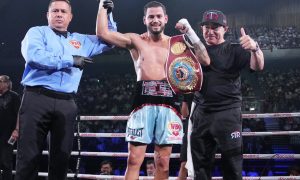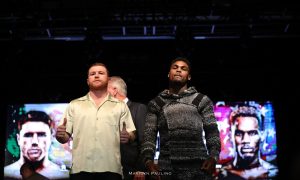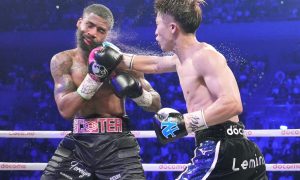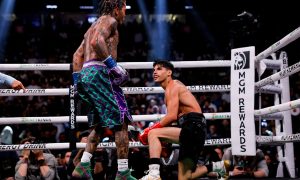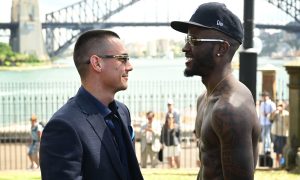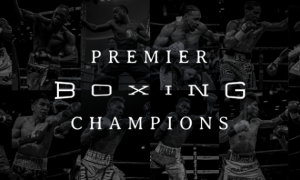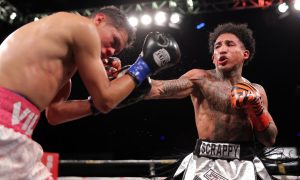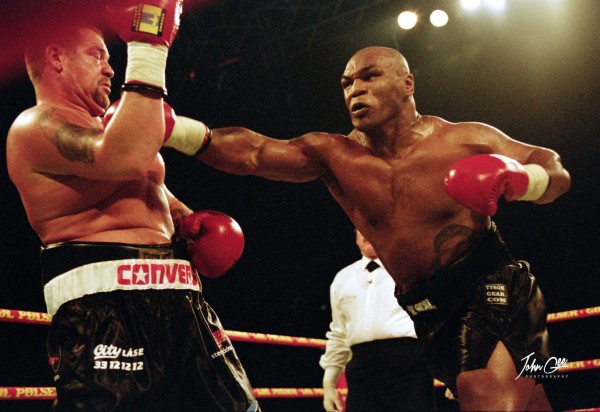 Photo by John Gichigi/Allsport
Photo by John Gichigi/Allsport
“I can hear you! The rest of the world can hear you! And the people…and the people who knocked these buildings down will hear all of us soon.”
A throng of rescue workers, police, and firefighters began to roar, “USA! USA! USA! USA! USA! USA! USA! USA!”
Standing on top of a mangled fire truck just three days after the September 11 attacks, President George W. Bush held a bull horn while speaking to the hundreds working at Ground Zero.
In office less than eight months, President Bush was, as were all Americans, working through the horrors of that fateful Tuesday morning in September when America fell under attack and thousands perished.
The year was 2001.
Headlines across the country voiced outrage. The Baltimore Sun headline stated, “DEVASTATION.” The Indianapolis Star read, “ATTACKED.” Several others, including Eugene, Oregon’s The Register-Guard read, “Unthinkable.”
The United States planned for both securing the homeland and for a response to those responsible.
While countless grieved in those dark hours, a country united. Many relished breaks from the devastation by watching the New York Yankees, so close to Ground Zero, battle the Arizona Diamondbacks in the World Series.
Some things, even during the darkest of hours, hadn’t changed. Sports, such a fiber in the American fabric, provided a distraction. For boxing fans, October marked the return of Mike Tyson as he prepared to face Brian Nielsen.
The bout, televised on Showtime, was the main event on a two fight card from Copenhagen, Denmark. Outside the temperature was 53 degrees. Inside, where the retractable roof was closed, it was a bit more comfortable as over 20,000 fans packed Parken Stadium.
Steve Albert and Bobby Czyz teamed to call the action.
Albert summed up the mood of the evening in his opening comments, “Tyson will headline this boxing doubleheader from a city that has welcomed us with open arms during these difficult times. We hope that this sporting can serve as a much needed diversion back home.”
Originally scheduled for September 8, the fight was postponed by the Tyson camp as the former champion was suffering from back spasms. His opponent, the 36-year-old Nielsen, remained his foe for the newly scheduled date of October 13.
Now 35, Tyson, (48-3, 42 KOs) had not fought in 51 weeks. His last action was a two-round beating that he coldly administered to Andrew Golota. After six minutes of sustained punishment, the Polish Heavyweight quit in his corner and refused to reenter the fray.
Tyson’s TKO victory was later ruled a No Contest after his refusal to take a pre-fight drug test. He then submitted to and failed a post-fight test.
Plagued by inactivity, Tyson was still ranked No. 1 by the WBC. Many believed that a win against Nielsen would secure a title shot against the winner of the following month’s rematch between Hasim Rahman and Lennox Lewis.
Many American fight fans wondered, who is Brian Nielsen and does he have any chance against “Iron” Mike?
Nielsen (62-1, 43 KOs) had only one loss in 63 bouts. The level of competition he had faced was viewed as suspect at best. In fairness, Nielsen had defeated a variety of recognizable names like Larry Holmes, Tim Witherspoon and Tony Tubbs.
The problem wasn’t the names, it was with point of their career that Nielsen caught up with them. All were well past their prime and effectively at the end of the road.
Nielsen, standing 6’3”, owned nearly a four-inch height advantage over Tyson as well as a 21 pound weight advantage. Nielsen had tipped the scales at nearly 260 pounds.
A wildly enthusiastic crowd had poured into Parken Stadium to see not only the former champion, but also to all see their hometown hero. Nielsen was born in Korsoer, Denmark and, in a recent poll, he placed second in “most popular person in Denmark”.
Understandably, first place went to the Queen. Albert shared a story from their fighter meeting with Nielsen in which he was asked if he believed he would be more popular if he beat Tyson. Nielsen replied, “How could I possibly be any more popular than I am now?”
Confidence and bravado didn’t seem to be an issue for Nielsen.
As both men warmed in their dressing rooms, the national anthems of both Denmark and the United States were performed. Tyson paced like a caged tiger while he shadow boxed in his dressing room. He wore a blue hooded sweatshirt with a New York Yankees emblem.
Two ring announcers were in the ring, Jimmy Lennon Jr. and Mogens Nymann, as each shared the duties of introducing the referee, Steve Smoger, and then fighters.
Each man received thunderous applause from the 20,000 plus fans in attendance.
Round 1 began with Tyson, wearing his trademark black trunks and black shoes, showing the world that his game plan was to seek and destroy. He attacked with a fusillade of punches and pounded to the body with zeal. Nielsen, in full retreat, covered up and looked to weather the early storm.
Albert summarized the first 60 seconds of combat, “Nielsen absorbing a lot of punishment early.”
Nielsen was able to survive the early onslaught. The second round was more of the same as Tyson, with his knees bent and while moving his head side to side, continued the assault. Still trying to weather the storm, Nielsen carefully picked his spots and countered where he could.
The enormous pressure Tyson was applying had taken its toll early as a cut was opened over the left eye of Nielsen late in the second round. Blood also began to trickle from his nose.
Although absorbing a tremendous amount of punishment, Nielsen was game and, like a toothache, wouldn’t go away.
With 30 seconds remaining in Round 3, and with the crowd now trying to rally Nielsen, Tyson stepped in and unleashed a vicious six-punch combination.
Albert bellowed, “Oh! Quick combination to the head! And down goes Nielsen! Down for the second time in his career!”
Not since Hulk Hogan slammed Andre the Giant had a man hit the deck that hard. Nielsen crashed onto his posterior, the ropes keeping him inside the ring, as the crowd rose and roared in euphoria.
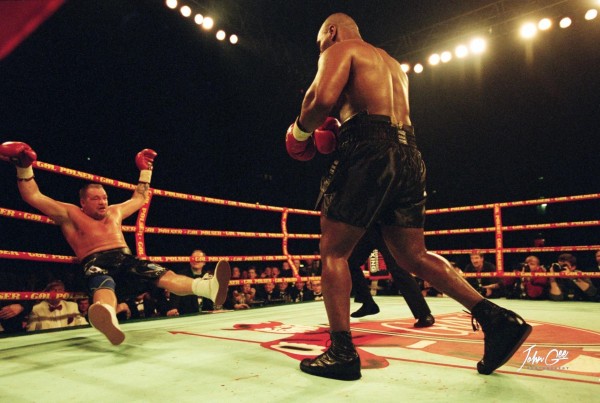 Photo by John Gichigi/Allsport
Photo by John Gichigi/Allsport
Nielsen climbed to his feet at the count of six leaving Smoger to ask, “How you feel Bri?” Nielsen nodded his head signaling he was ready to continue. Smoger responded to Nielsen’s willingness to carry on and signaled for the action to resume, “You’re beautiful babe!”
Nielsen again survived.
As the bout progressed into Rounds 4 and 5, one began to wonder if the Nielsen strategy might have been pinned on the hopes of Tyson punching himself out. “Iron” Mike continued to dig to the head and body with hooks and uppercuts.
The crowd was still firmly into the action even as Tyson continued to dominate. Albert observed, “Almost everything is connecting by Tyson. The crowd, hoping for a miracle here.”
Now in Round 6, Czyz added, “Nielsen is so big, he’s very strong physically.”
Tyson, working more behind his jab now than at any other point in the fight, continued to rock side to side and viciously hammer away at Nielsen. The blood continued to flow as Nielsen’s eye was now swelling. He was now nothing more than a heavy bag as his attempts to return fire had all but faded.
Both fighters returned to their corners with six rounds now complete. Tyson’s corner was pleased with his combinations and asked that he now begin to double and triple his jab.
Across the ring, Nielsen remained on his stool as the bell sounded to being Round 7. Smoger, quickly made his way into the corner.
Complaining he could no longer see out of his left eye, Nielsen was unwilling as much as he was unable to continue.
After a conversation in the corner between Smoger and Nielsen, Smoger called a halt to the action. Tyson earned victory number 49 via a TKO.
In the years to come, Nielsen would step into the ring just three more times. He would end his career, at home in Copenhagen, with a loss to former Heavyweight champion Evander Holyfield.
Tyson would go on to challenge Lennox Lewis the following June for the Heavyweight crown. He took a hellacious beating at the hands of the champion and would fight just three more times after losing to Lewis.
Although he was far from his prime against Nielsen, the bout came at a pivotal time in history.
Tyson, from Catskill, NY, fought Nielsen while millions watched while coping with the uncertainty of tomorrow. Led by United States and British forces, Operation Enduring Freedom was launched in Afghanistan just one week before the bout on October 7.
For those who lived through that time, all of us remember where we were and what we were doing on that Tuesday morning in September.
It is a moment we shall never forget.






